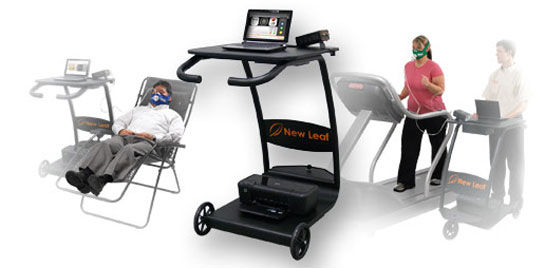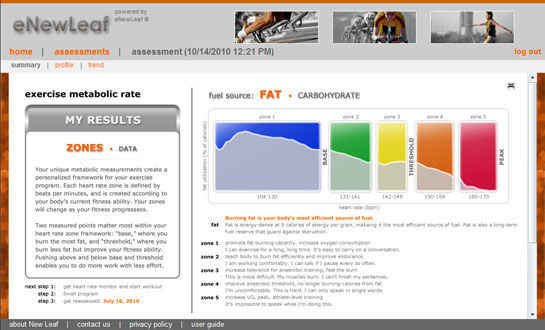
By FABIO COMANA, M.A., M.S.
New LeafTM Active Metabolic Training System
Increasingly, the fitness industry is focusing on tacking the problems of obesity and weight management. As a result, we are experiencing a surge in fitness- and nutrition-related products, each claiming to be the best solution to boosting metabolism and accelerating weight loss. While these claims generally go beyond any realistic measure of truth, there is a need for a device that accurately measures caloric expenditure at rest and while performing any activity or exercise.
The New Leaf Active Metabolic Training System determines your metabolic profile via a breath (gas) analyzer that quantifies your resting metabolism, caloric burn rate during activity or exercise, and even analyzes your fuel utilization efficiency (your ratio of fat-to-carbohydrate being burned as fuel). Their metabolic analyzer was created using the medical research and technology of parent company Medical Graphics (a subsidiary of Angeion), which developed the MedGraphics™ clinical diagnostic systems used in many hospital- and performance-based settings. Using a small neoprene mask, this device accurately measures oxygen and carbon dioxide quantities, as well as the total volume of air moving through the lungs. With this information, it generates the user’s metabolic profile. Many health clubs and wellness centers are now offering this technology to individuals at an average cost of $100–$150 for resting metabolism or exercise assessment, or approximately $150–$200 for both.

The interactive component of the New Leaf system, called eNewleaf™, is a Web-based platform where individuals, trainers/instructors and facilities can track results and progress. Data collected during testing is uploaded to a secure account and allows individuals to view and trend his or her own metabolic results. eNewleaf offers various user-friendly tools, from planning and programming to tracking and reporting, which are designed to interface with the device and a heart-rate monitor. Customized programs are loaded into an exercise calendar and e-mailed or downloaded to a portable device. The programming tools, from which the cardio and performance (anaerobic) programs are developed, are all created from an individual’s unique metabolic markers, rather than from the outdated and inaccurate standard formulas of percent-maximal heart rate and heart-rate reserve. Ultimately, this allows an exerciser to achieve real results in less time and with greater ease because the recommended training parameters and intensities are based on his or her unique metabolism.
In addition to the financial investment, perhaps the biggest obstacle to accessing this technology is locating a facility that actually offers metabolic assessments. Naturally, this technology is not cheap ($7,000–$10,000 per facility installation), so availability is limited, particularly in smaller markets. The NewLeafFitness Web site allows users to search for a facility by zip code and designated mile radius. For example, a 25-mile radius search from ACE headquarters in San Diego yielded four New Leaf centers.
What we liked:
- True metabolic assessments and profiling
- Customized programming based upon an individual’s own metabolism and not generic, and often inaccurate, mathematical equations
- Better results in less time and with less effort
- User-friendly, colorful and engaging charts and graphs
- Comfortable neoprene mask and ease-of-testing
What we did not like:
- Accessibility is still limited in some markets
- Cost per test may prove prohibitive for some people
- Start-up costs for a facility are significant

www.newleaffitness.com
www.eNewLeaf.com
_________________________________________________________________________

Fabio Comana, M.A., M.S., is an exercise physiologist and spokesperson for the American Council on Exercise, and an adjunct professor at San Diego State University (SDSU) and the University of California San Diego (UCSD), teaching courses in exercise science and nutrition. He holds two master’s degrees, one in exercise physiology and one in nutrition, as well as certifications through ACE, ACSM, NSCA and ISSN.